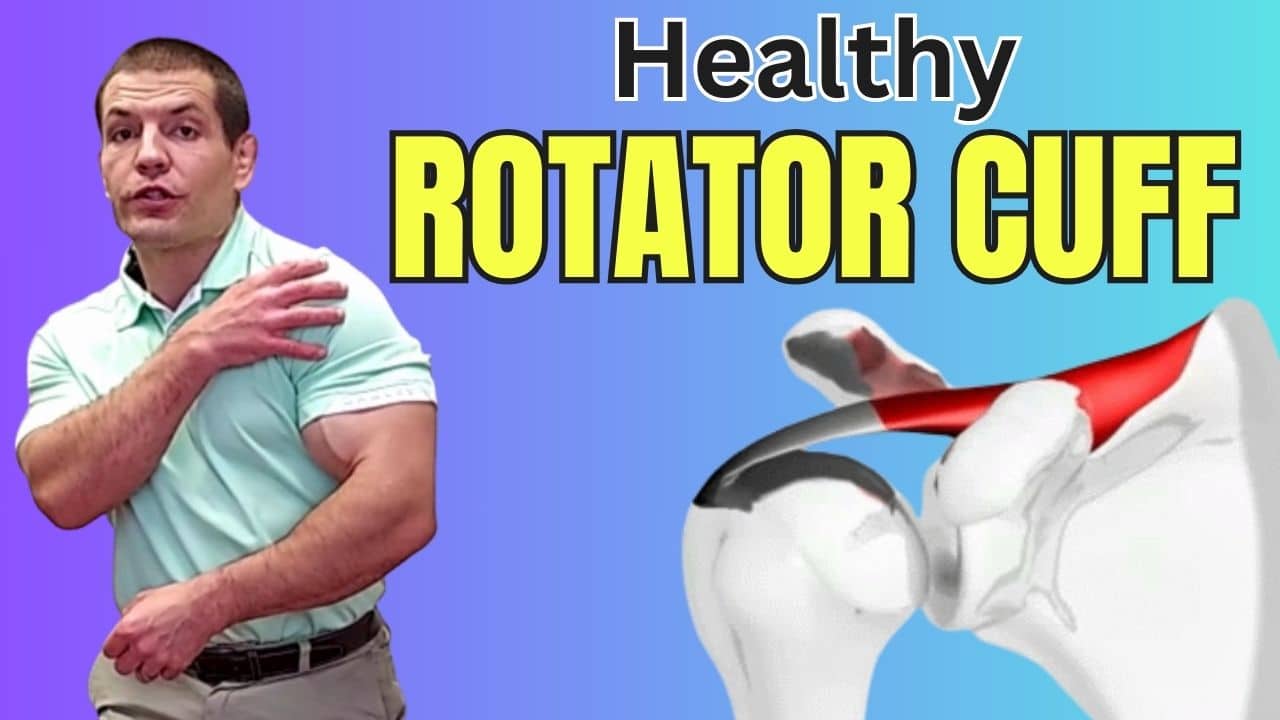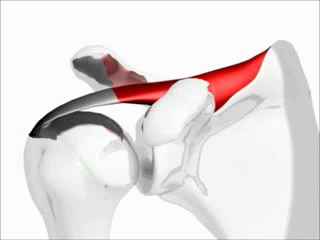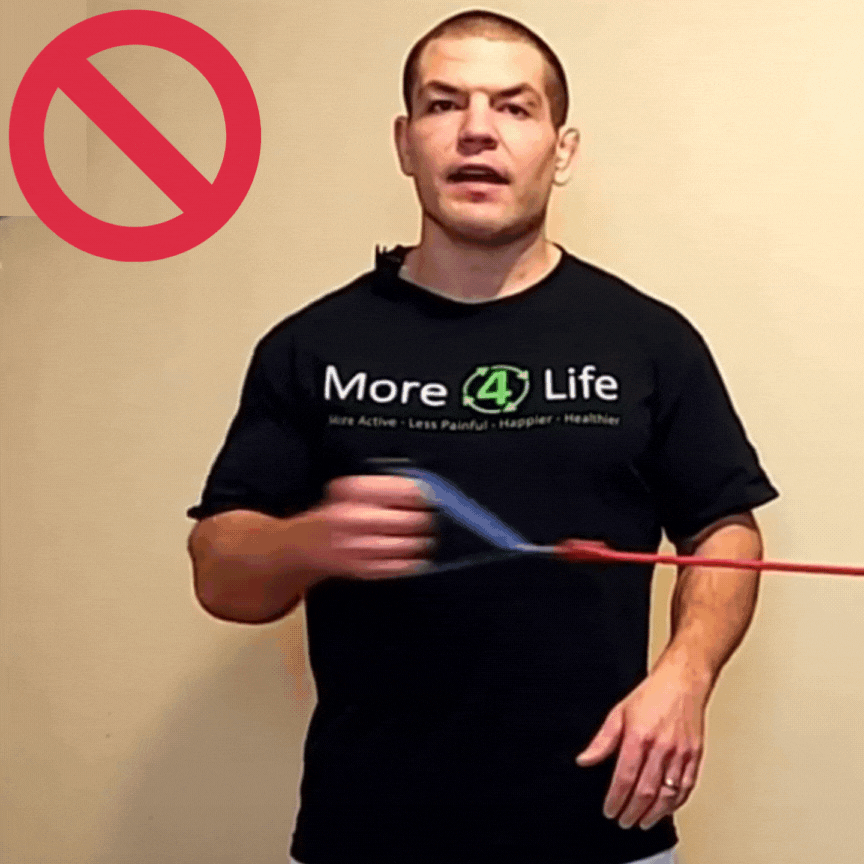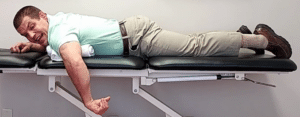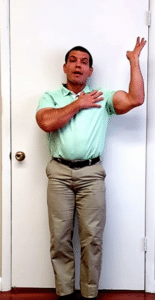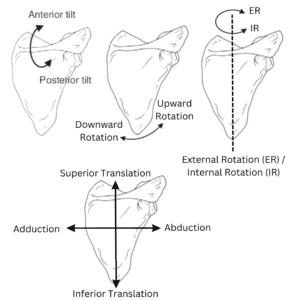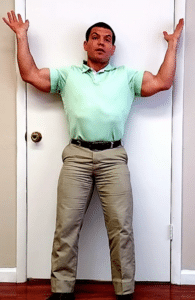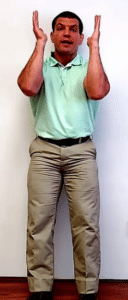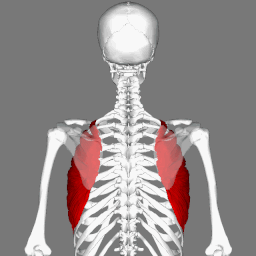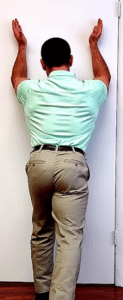What Are The Best Shoulder Impingement Exercises?
If you have shoulder impingement, you may have pain reaching overhead, reaching across your body, or reaching behind your back. If that's the case the 9 shoulder impingement exercises in this video can help you relieve shoulder pain and improve your shoulder mobility. But chances are, you probably only need 2-4 of them in order to relieve your shoulder pain.
Watch the video to learn how to do the exercises, plus which ones may work best for you.

Table of Contents
- What Is Shoulder Impingement Syndrome?
- 9 Shoulder Impingement Exercises
- Sleeper Stretch
- Supine Shoulder Internal and External Rotation
- Prone Shoulder Internal and External Rotation
- Standing Back to Wall Shoulder Internal and External Rotation
- Doorway Chest Stretch
- Standing Back to Wall Chest Stretch
- Standing Back to Wall Lat Stretch
- Standing Facing Wall Serratus Anterior Wall Slides
- Standing Facing Wall Lower Trapezius Wall Slide
- Conclusion
What Is Shoulder Impingement Syndrome?
Before we discuss the best shoulder impingement exercises, you first need to understand what exactly shoulder impingement is.
Shoulder impingement really just means that there's a narrowing of the space or an impingement of the space where your rotator cuff tendons run.
As you can see from the image above, there's a really small space over the top of your shoulder called the subacromial space.
There are a lot of structures that have to run through the space such as your rotator cuff tendons, subacromial bursa, and your biceps tendon.
That space is only about 1 cm to begin with. If you have bad posture or have bone spurs in your shoulder, that can further narrow the space.
Additionally, your shoulder is a ball and socket joint. When you move your arm, the ball (humeral head) rotates on the socket (glenoid fossa).
If the ball of the shoulder moves either to high in the socket or too far forward in the socket, it can cause shoulder impingement.
Shoulder Impingement Involves 4 Joints
I mentioned your shoulder is like a ball and socket joint, but it's actually a little bit more complex than that.
Your shoulder complex is made up of four different joints:
- The ball and socket joint
- The joint between your sternum and your collarbone (sternoclavicular joint)
- The joint between your collarbone and your shoulder blade (acromioclavicular joint)
- A pseudo joint between your shoulder blade and the back of your rib cage (scapulothoracic articulation)
You don't really need to think of all four of those joints though.
You just need to think about two different kinds of movement when you move your shoulder.
One is just the movement at that glenohumeral joint, or the ball and socket joint
The second is the movement of your shoulder blade on the trunk.
Glenohumeral Exercises For Shoulder Impingement
As you raise your arm, you need to be able to keep the ball centered in the socket. That way the ball doesn't impinge on the rotator cuff tendons and the other structures that run through the subacromial space.
Shoulder impingement syndrome usually causes pain with movements such as:
in order to do these movements, you need to have good mobility in the back part of the shoulder joint.
Sleeper Stretch
The sleeper stretch is an exercise that helps focus on the flexibility or mobility of the back part of the shoulder or the posterior capsule.
Here's how you do the sleeper stretch:
You'll start out lying on your side with your arm at a 90 degree angle to your body and elbow bent 90 degrees
The classic description of the sleeper stretch is just to press your arm down toward the bed.
However, if you already have shoulder impingement, you can actually pinch or impinge on the space where the rotator cuff tendons run as you're doing this exercise, and so that can actually create some shoulder pain.
Modified Sleeper Stretch For Shoulder Impingement
A way that you can keep that ball from pinching on those tendons as you're doing the sleeper stretch is just to use your opposite hand and put a little bit of pressure right on the ball.
That way you're using your hand to keep the ball centered in the socket.
Sincemyou don't have your hand available to press your wrist down, place the elbow over top of your wrist and then hold just a GENTLE pressure there.
You don't need to push as hard as possible. Just go till you feel a gentle stretch in the back of your shoulder.
Don't stretch to the point of pain!
The sleeper stretch is intended to address the capsular tissue in the back of your shoulder, and capsular tissue doesn't stretch out quickly.
So, you don't want this to be an extremely hard, aggressive stretch.
It should be a slow, gentle stretch where you hold just a sustained pressure over a long period of time.
Some research has shown that it's supposed to be 10- to 15-minute bouts, 3 to 6 times per day, but that's a long time to stretch!
So, start with five minutes, if you can work up to 10 minutes, that's great. Some stretching is better than no stretching at all.
Just do a very gentle pressure that you can hold for several minutes.
3 Motor Control Shoulder Impingement Exercises
After you've improved the mobility of your shoulder, next you want to improve the motor control.
What I mean by motor control is coordination.
You've got to be able to control the ability to move and rotate the ball of your shoulder in the socket without excessively moving your shoulder blade on your trunk.
Why Common Rotator Cuff Exercises Don't Always Help Shoulder Impingement
A shoulder impingement exercises involve doing internal and external rotation exercises using an elastic band.
These are exercises designed to strengthen your rotator cuff.
While one of the functions of the rotator cuff IS to stabilize the ball in the socket, there are several problems with these kinds of rotator cuff strengthening exercises.
One problem is that most people don't focus a lot on the control aspect... they just focus on strength.
So often people a lot of times allow their shoulder blade to get into the movement doing it mindlessly.
Now, if you are going to do that exercise, I would recommend putting a towel between your arm and your body.
Keep your elbow nice and still, and do a pure rotation of your forearm around the long axis of your upper arm.
But really, most shoulder impingement problems don't happen with your arm by your side. They happen with your arm up at shoulder level.
Really, you want to work on internal and external rotation with your arm at 90 degrees.
So here are a few different ways that you can do that.
Supine Shoulder Internal and External Rotation
The easiest way to do shoulder internal and external rotation is lying on your back with your arm propped up on a towel.
It is important to have your arm propped up because if your elbow drops back this way, it pushes the ball of your shoulder forward in the socket.
Then practice rotating your arm back and forth as far as you can go into internal and external rotation.
Notice that I put the other hand on the front of the shoulder joint.
You don't want to allow the ball of your shoulder to pop forward or for your shoulder blade to tip forward as you're doing this exercise.
You're not actually applying pressure with this hand. You're just feeling with your fingers and making sure that the ball and socket stay nice and still.
The exercise shoulder just be a pure rotation of your arm.
Picture an axle running through your upper arm bone. You're just rotating your forearm back and forth around that axle.
And so that's the first exercise.
Prone Shoulder Internal and External Rotation
The second shoulder rotation exercise is actually very similar to the first one. However, instead of laying on your back with a towel under your elbow, you lay on your belly with your forearm hanging off the table and the towel under your shoulder.
In this position, the hardest parts of the range of motion are against gravity.
Your muscles are strongest in mid-range internal and external rotation and weakest at both end-ranges.
When you're lying on your back, gravity is helping you to move into both internal and external rotation. However, when lying on your belly, gravity is resisting you at end-range external rotation and internal rotation.
Therefore, this exercise has more of a strengthening component than the previous one. For that reason, you may not get as much range of motion as when you're lying on your back.
Remember not to "cheat" in your technique in order to get more range of motion. You just want pure rotation of your forearm around your upper arm around the upper arm.
Standing Back to Wall Shoulder Internal and External Rotation
For the third shoulder rotation exercise, stand with your back up against the wall.
This exercise uses the the same general movement pattern as the other two. However, now you have to support the weight of your arm against gravity while rotating.
To increase the difficulty of this exercise, remember from physics that force is mass times acceleration (F = m*a).
So after you've got the motor control down, if you move faster, that will increase the difficulty of the exercise. That's why it takes so much force to throw a 5-oz baseball 100 miles per hour. It's not the weight of the ball... it's the acceleration.
If that gets too easy, you can add a water bottle, a can of soup, or a small hand weight to help further increase the difficulty of the exercise.
So those were the exercises to focus on the ball and socket joint. Next, I'll discuss shoulder impingement exercises that address the movement of the shoulder blade on the trunk.
Shoulder Impingement Exercises For The Scapula
When you raise your arms, the shoulder blades (scapulae) have to move away from the spine and out to the sides. Those movements are referred to as scapular abduction and upward rotation, respectively.
When your scapula upwardly rotates, that raises socket of the shoulder. That prevents the humeral head from impinging on the to subacromial space mentioned earlier. N
You need to have good flexibility in your chest muscles as well as your latissimus dorsi ("lat") muscles in order to allow that upward rotation to happen.
So here are some flexibility exercises that you can use to improve your chest and lat flexibility.
Doorway Chest Stretch
The first way to stretch your chest muscle is to stand in a doorway. Put your forearms against the doorframe, and slowly walk toward it.
You don't want to lean forwards on the doorframe because then your arms are contracting (shortening) to hold you up while you're trying to stretch them.
That doesn't work.
So you want to be able to free-stand in the doorway. Just take a small step in, but don't lean.
If you have to get all the way through the doorframe to feel a stretch, you probably don't need to do this exercise to begin with.
Hold the stretch 1-2 minutes.
This stretch to helps improve both external rotation at the ball-and-socket (glenohumeral) joint as well as chest flexibility and backward tilt of your shoulder blade.
Standing Back to Wall Chest Stretch
A progression on the chest stretch is to do the same position without a doorframe to hold your arms up.
You can do this by standing with you back against a door or wall.
You're now stretching your chest muscles, AND also strengthening your upper back muscles as well as your rotator cuff muscles.
That makes this a very efficient exercise because you get a 3-for-1 benefit from this exercise.
Make sure to keep your lower back flat on the wall during this exercise. Your heels should be about 12-18 inches away from the wall in order to allow you to keep your back flat.
You want to rotate your wrists and hands back toward the wall to get shoulder external rotation and scapular posterior tilt.
However, your elbows do not need to be touching the wall.
In fact, they probably should not touch the wall.
If you can get your elbows back on the wall, chances are you probably don't need to be doing this exercise in the first place.
Additionally, by having your elbows in front of your wrists, that creates more external rotation in your shoulder joint.
So that's the second flexibility exercise for your chest.
Standing Back to Wall Lat Stretch
This exercise will help stretch your lats while strengthening your rotator cuff at the same time.
To do this, you'll stand with your back flat against the wall or the door as in the previous exercise.
However, instead of having your arms out to the side, this time put your elbows directly in front of your shoulders. Your forearms should be vertical and parallel with each other.
To do this, you have to actively externally rotate your shoulders. Doing this strengthens your rotator cuff muscles while also stretching your lats.
To intensify the stretch, raise your arms up towards the ceiling, ONLY as far as you can without letting elbows flare out. (Note that my right elbow [left side of picture] is starting to flare out just a little in the picture above.)
If your elbows flare out, that causes shoulder internal rotation.
And shoulder flexion with internal rotation is the impingement position, which is what you're trying to avoid.
Therefore, keep your forearms parallel, and only go up as far as you can without allowing that internal rotation.
So that's an active lat stretch you can do if you have shoulder impingement. That exercise would be best if you have shoulder impingement symptoms when reaching overhead in front of you.
If you have trouble more with things like lifting your arm out to the side, then perhaps this exercise like the chest stretch would be better for you because it's more in the out-to-the-side plane.
Shoulder Impingement Exercises To Strengthen Scapular Muscles
The final two exercises are similar to the back-to-wall chest and lat stretches, but this time, you'll be facing the wall.
The goal of these exercises is to strengthen the muscles that move your shoulder blades. Namely, those are the serratus anterior and the lower trapezius.
Standing Facing Wall Serratus Anterior Wall Slides
This exercise helps strengthen the serratus anterior muscle.
The serratus anterior is one of the muscles responsible upwardly rotating your shoulder blades as you raise your arms over your head.
To strengthen your serratus anterior, put your arms up on the door. Your forearms should be pointing vertically and parallel with each other as with the lat stretch.
Put some pressure into the door with your forearms. Then slide your arms upwards, again trying to keep your forearms parallel. (If there's too much friction to slide, use a towel between your forearms and the door.)
Standing Facing Wall Lower Trapezius Wall Slide
The last shoulder impingement exercise that I'll show is similar to the serratus anterior slide on the wall, except you'll slide your arm up the wall like the letter "Y."
Slide up as high as you can WITHOUT allowing your shoulders to shrug and then do a slight lift-off (about 1/4 to 1/2 inch).
The lift-off shouldn't come from the shoulder (glenohumeral) joint. It's should come from tipping your shoulder blades backward.
Doing this activates the lower trapezius muscle. (Dark red/ purple part of the muscle below)
This muscle helps tip your shoulder blade backward and upwardly rotate the shoulder blade. It also prevents you from shrugging your shoulder excessively when reaching overhead.
This exercise is helpful for someone who tends to have high-riding shoulders or sits at a desk with their shoulders tensed all day.
If you have stiffness in the upper trapezius (orange part of muscle), strengthening your lower trapezius may be a good idea to help counteract that stiffness.
Conclusion
Here's a review of the 9 shoulder impingement exercises:
- Sleeper Stretch
- Supine Shoulder Internal and External Rotation
- Prone Shoulder Internal and External Rotation
- Standing Back to Wall Shoulder Internal and External Rotation
- Doorway Chest Stretch
- Standing Back to Wall Chest Stretch
- Standing Back to Wall Lat Stretch
- Standing Facing Wall Serratus Anterior Wall Slides
- Standing Facing Wall Lower Trapezius Wall Slide
That may seem like an overwhelmingly long list, but you probably don't need to do all 9 exercises.
Usually doing just 1 or 2 exercises to address the glenohumeral (ball-and-socket) joint movement and 1 or 2 exercises to address the scapulothoracic (shoulder blade) movement is enough to get good results.
If you aren't sure which exercises are best for you, you may want to get help from a a expert physical therapist.
Some situations where you may want to consider getting treatment for shoulder impingement are:
- You have a more complex problem that you need addressed.
- You've tried physical therapy in the past and it didn't work.
- You need hands-on treatment in addition to exercises.
- You're nervous that you'll make mistakes doing exercises on your own.
- You want to feel better as quickly as possible, and you'd rather not go through the trial-and-error of figuring it out on your own.
If any of those situations apply to you, we'd be happy to help you. Just tap the button below to request an appointment with one of our specialists.

